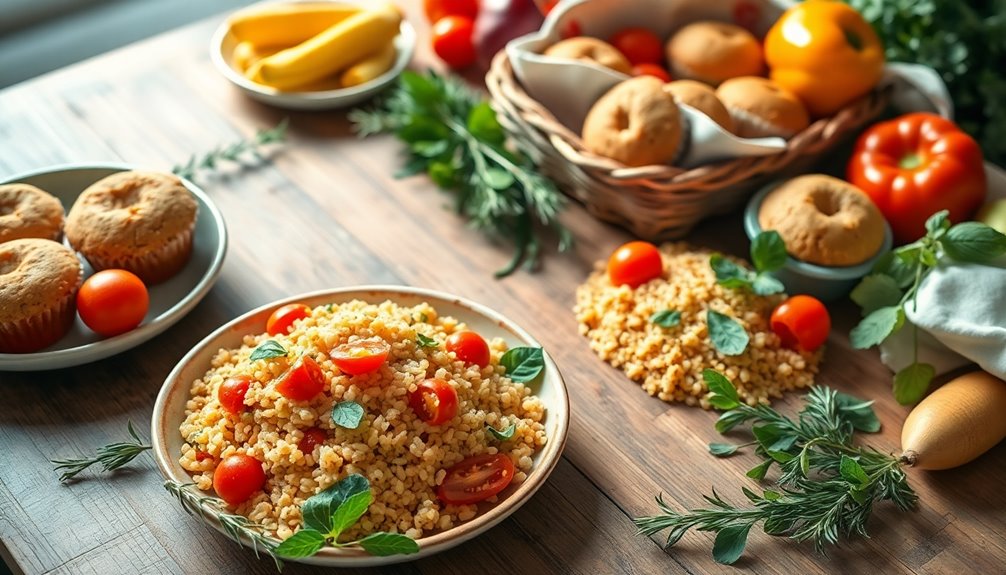A gluten-free diet means cutting out gluten, a protein found in wheat, barley, and rye. This can help those with gluten sensitivity or celiac disease experience improved health, like better digestion and increased energy. However, misconceptions exist; going gluten-free doesn't always guarantee a healthier diet. You'll face challenges, like limited food options and cross-contamination risks, especially when dining out. Focus on incorporating essential gluten-free foods like quinoa and almond flour into your meals. With thoughtful planning, you can thrive on this diet. You might discover even more tips and benefits as you explore gluten-free living further.
Key Takeaways
- A gluten-free diet eliminates gluten-containing grains like wheat, barley, and rye, essential for those with celiac disease or gluten sensitivity.
- Health benefits may include weight loss, improved digestion, and increased energy, but gluten-free does not always mean healthier options.
- Essential gluten-free foods include quinoa, brown rice, gluten-free oats, and various flours like almond and coconut.
- When dining out, research restaurants, communicate dietary needs, and be aware of cross-contamination risks.
- Online communities offer support, recipes, and tips for transitioning to a gluten-free lifestyle, emphasizing progress over perfection.
Understanding Gluten and Its Sources
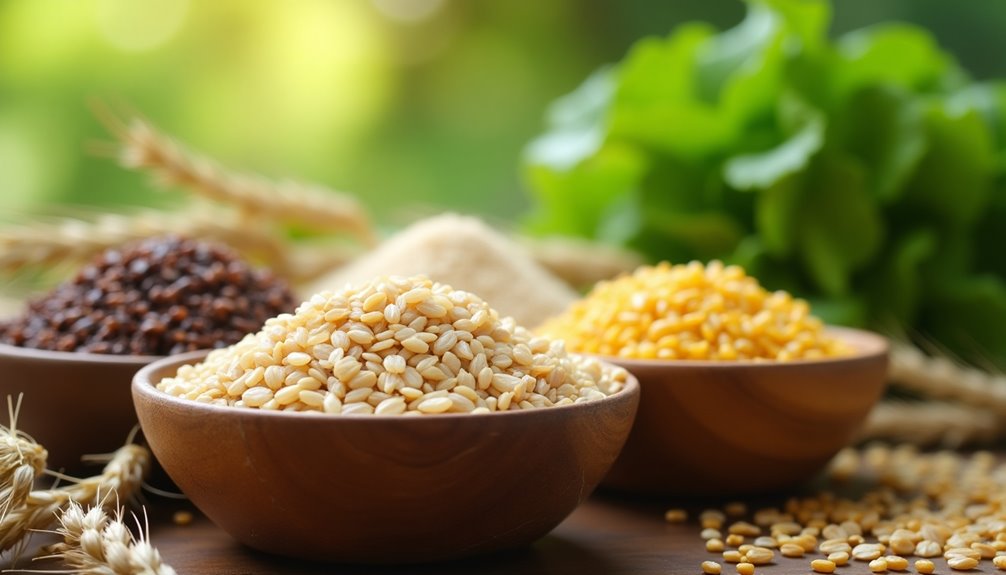
Gluten, a protein found in wheat, barley, and rye, plays an important role in the texture and elasticity of many foods we enjoy. However, for some, gluten can trigger discomfort or adverse reactions. If you've ever felt bloated, fatigued, or experienced digestive issues after consuming gluten-containing foods, you might be dealing with gluten sensitivity. This condition affects a significant number of people, leading to an array of symptoms that can impact daily life.
Understanding where gluten hides is vital. It's prevalent in bread, pasta, cereals, and many processed foods. Even seemingly harmless items like sauces and dressings can contain gluten, so it's important to read labels carefully.
If you're considering a gluten-free lifestyle, you'll find that there are numerous gluten-free alternatives available today. Options like quinoa, rice, and gluten-free flours made from almonds or coconut can help maintain the texture and flavor you love without the discomfort that gluten may cause. Additionally, being aware of the health dangers of traditional bread can further motivate your dietary changes.
Exploring gluten-free alternatives doesn't mean you have to sacrifice taste. Many brands now offer gluten-free versions of your favorite snacks and meals, ensuring you still feel included in social settings. Embracing this change can lead to new culinary adventures, and you might discover delicious meals you never considered before.
Health Benefits of Going Gluten-Free
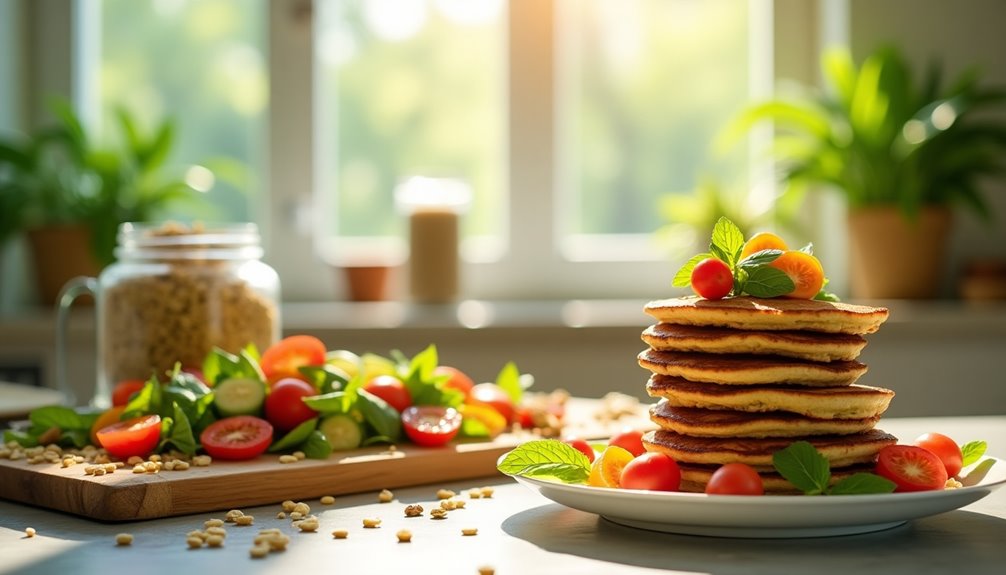
Many people experience significant health benefits when they adopt a gluten-free diet, particularly those with gluten sensitivity or celiac disease. By eliminating gluten from your meals, you may notice improvements in various aspects of your health and well-being. Here are some key benefits to keep in mind:
- Weight loss: Many individuals report shedding pounds when they eliminate gluten, often due to a decrease in processed foods and a focus on whole ingredients.
- Increased energy: Without gluten, your body may feel lighter and more energized, as it can utilize nutrients more effectively without the inflammation that gluten can trigger.
- Improved digestion: For those sensitive to gluten, going gluten-free can result in fewer digestive issues, such as bloating and gas.
- Enhanced mental clarity: Some find that removing gluten helps enhance their focus and reduces brain fog, making it simpler to concentrate on daily tasks.
While the gluten-free diet can provide these benefits, it's crucial to make sure you're still getting a balanced diet rich in vitamins and minerals. You can achieve this by incorporating a variety of gluten-free grains, fruits, vegetables, and proteins. Additionally, consider creating a custom keto diet plan to optimize your nutrition while adhering to gluten-free guidelines.
As you navigate this dietary change, you might also discover new foods and recipes, fostering a sense of belonging within the gluten-free community. Always consult with a healthcare provider before making significant dietary changes, especially if you suspect gluten sensitivity or celiac disease.
Common Misconceptions About Gluten-Free Diets
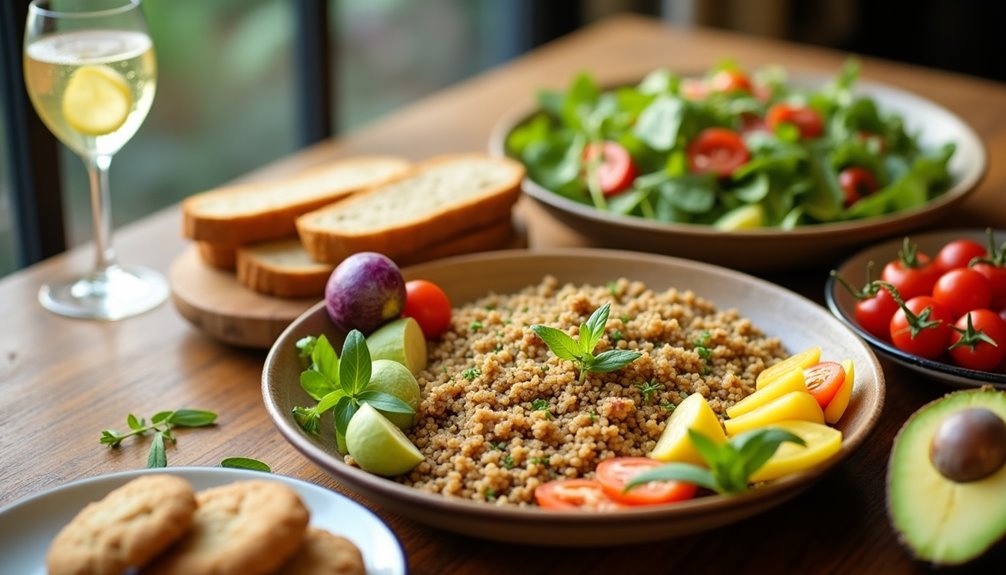
Adopting a gluten-free diet often comes with a host of misunderstandings that can misguide those looking to enhance their health. One common belief is that gluten-free automatically means healthier. While many gluten-free products are available, they can be just as processed and high in sugar and fat as their gluten-containing counterparts. It's important to focus on whole foods like fruits, vegetables, and lean proteins, regardless of gluten content.
Another misunderstanding is that gluten sensitivity is the same as celiac disease. While both involve adverse reactions to gluten, gluten sensitivity doesn't cause the severe intestinal damage found in celiac patients. If you're unsure about your sensitivity, consulting a healthcare professional is necessary for proper diagnosis and guidance.
You might also think that all gluten-free foods are safe without reading labels. This is misleading. Cross-contamination can occur during manufacturing, so thorough label reading is necessary to make sure the product meets your dietary needs. Some products may still contain trace amounts of gluten, which could impact those with celiac disease or severe gluten sensitivity.
Lastly, many people believe that going gluten-free will lead to immediate weight loss or improved energy levels. While some individuals notice benefits, it's not a guaranteed outcome for everyone. Each person's body responds differently, so it's important to approach the diet with realistic expectations. Understanding these misunderstandings will help you navigate the gluten-free landscape more effectively and make informed choices that truly support your health. Additionally, incorporating whole food ingredients into your meals can enhance your nutrient intake and overall well-being.
Challenges of a Gluten-Free Lifestyle
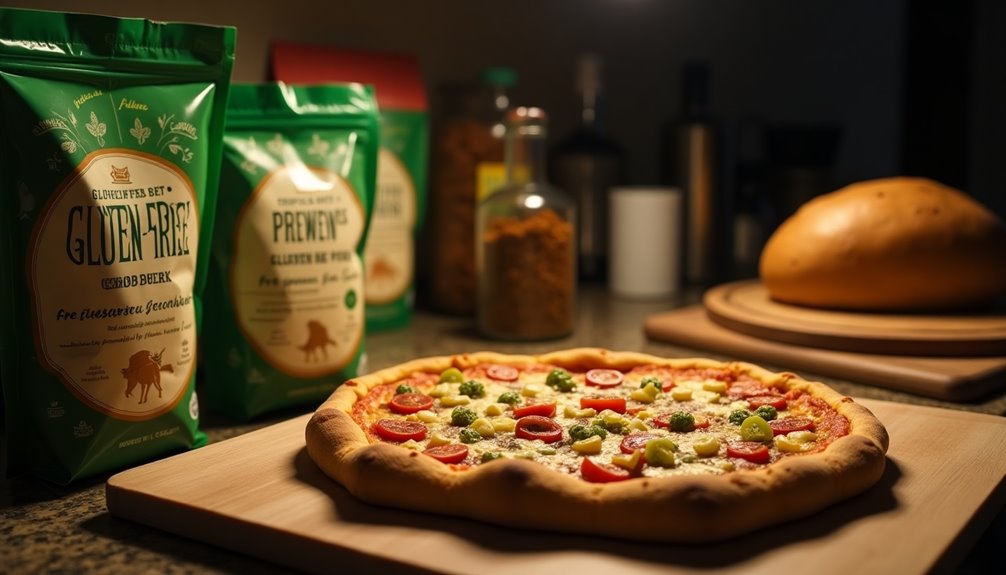
Managing a gluten-free lifestyle can present several obstacles, even for those who are aware of common misconceptions about gluten-free diets. Whether you're newly gluten-free or have been maneuvering this lifestyle for a while, it's important to recognize the hurdles you might face.
- Limited food options: Many restaurants and stores still lack choices for gluten-free individuals.
- Social gatherings: Attending parties or events can be tricky when gluten-filled foods dominate the menu.
- Traveling restrictions: Finding safe food while on the road or in foreign countries can feel overwhelming.
- Cross-contamination concerns: Even trace amounts of gluten can trigger symptoms, making it essential to stay attentive.
Social gatherings often pose a unique challenge. Friends and family may not fully understand your dietary restrictions, which can lead to awkward situations. It's crucial to communicate your needs upfront, but that doesn't always lessen the pressure you might feel. Additionally, managing a gluten-free lifestyle can be more challenging for individuals with Chronic Kidney Disease, as dietary restrictions may further limit food options and require careful planning.
Traveling can also become a logistical obstacle. You might need to plan meals in advance or research gluten-free restaurants, which takes time and effort. Some regions may not offer ample gluten-free options, making it essential to pack snacks or meals.
Transitioning to a Gluten-Free Diet
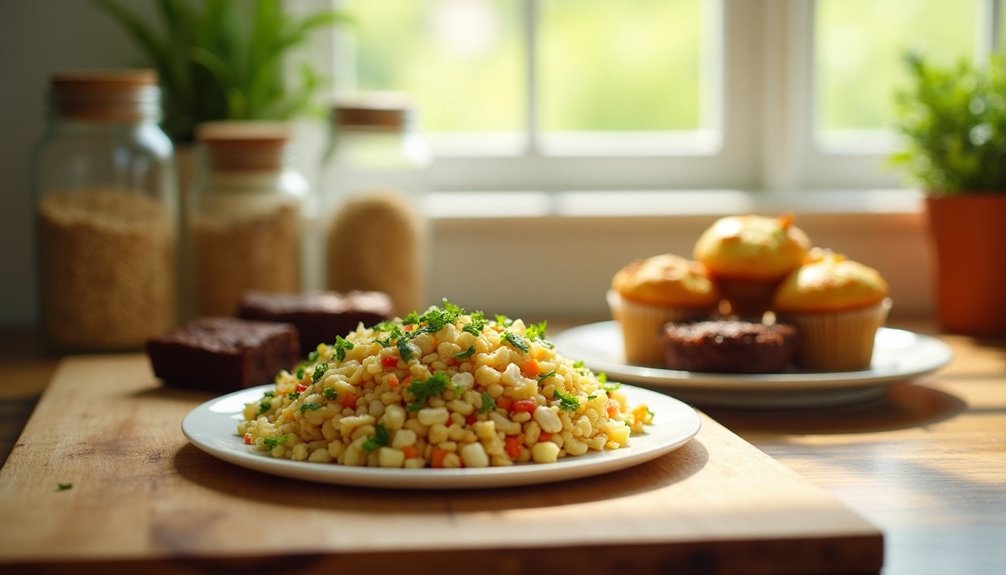
How do you start moving to a gluten-free diet without feeling overwhelmed? First, take a deep breath and remember that adapting is a gradual process. Begin with meal planning; this is your roadmap to success. Start by identifying your favorite meals and think about how you can adjust them.
Look for recipe substitutions that use gluten-free ingredients—like almond flour or gluten-free pasta—so you can still enjoy the flavors you love.
Create a weekly menu that incorporates these substitutions, and make a shopping list based on that plan. This helps avoid impulse purchases that might include gluten-containing items. When you're in the grocery store, focus on the perimeter where fresh produce, meats, and dairy are usually located; these areas often contain naturally gluten-free options.
As you make the change, keep an eye on labels. Many packaged foods contain gluten, so familiarize yourself with gluten-free certifications. You may also want to explore gluten-free grains like quinoa or rice to diversify your meals.
Don't hesitate to reach out to friends or online communities for support. Sharing your journey can foster a sense of belonging and provide valuable resources, including recipes and tips. Remember, the goal isn't perfection but progress. Each small step you take will make the adjustment smoother and more enjoyable, helping you embrace a gluten-free lifestyle with confidence. Additionally, consider how carbs are allowed on Half Day Keto, which can provide flexibility in your meal planning while transitioning.
Essential Gluten-Free Foods
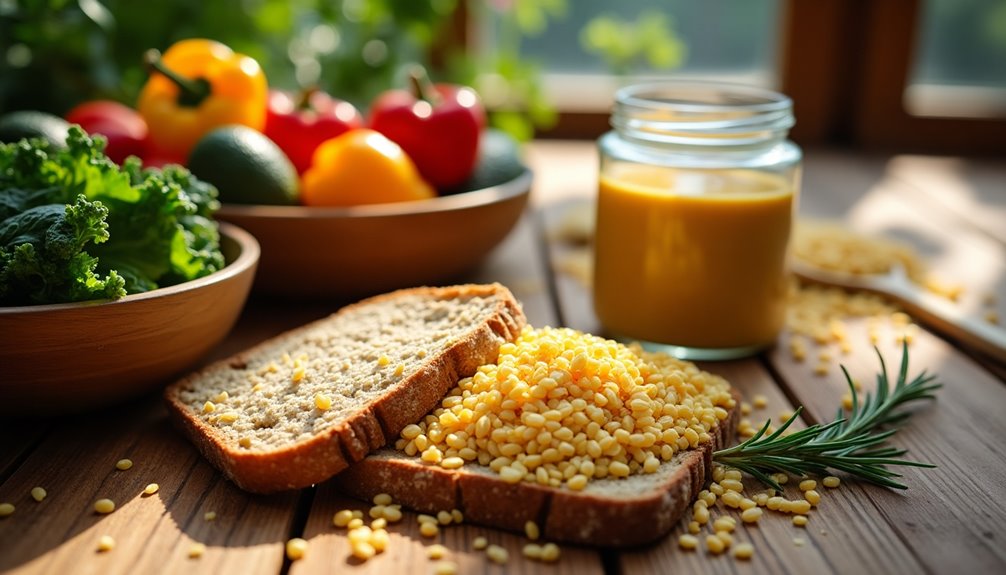
As you adjust to a gluten-free lifestyle, knowing which foods to stock your pantry and fridge with can make all the difference. Having a well-curated selection of essential gluten-free foods not only helps you avoid gluten but also ensures you enjoy delicious meals and snacks. Here's a quick guide to get you started:
- Quinoa and brown rice
- Gluten-free oats
- Almond flour and coconut flour
- Nut butter
First, consider incorporating whole grains like quinoa and brown rice. They're rich in nutrients and provide a great base for various meals.
Gluten-free oats are another fantastic option; they make for a hearty breakfast or can be used in gluten-free baking.
When it comes to snacking, having a stash of gluten-free snacks on hand is vital. Look for options like popcorn, rice cakes, or gluten-free granola bars. They're perfect for quick energy boosts during your day.
For those who love to bake, try stocking up on almond flour and coconut flour. These alternatives aren't only gluten-free but also add unique flavors and textures to your baked goods. You can create everything from cookies to bread without the worry of gluten. Additionally, incorporating plant-based protein into your meals can enhance your overall nutrition while following a gluten-free diet.
Tips for Dining Out Gluten-Free
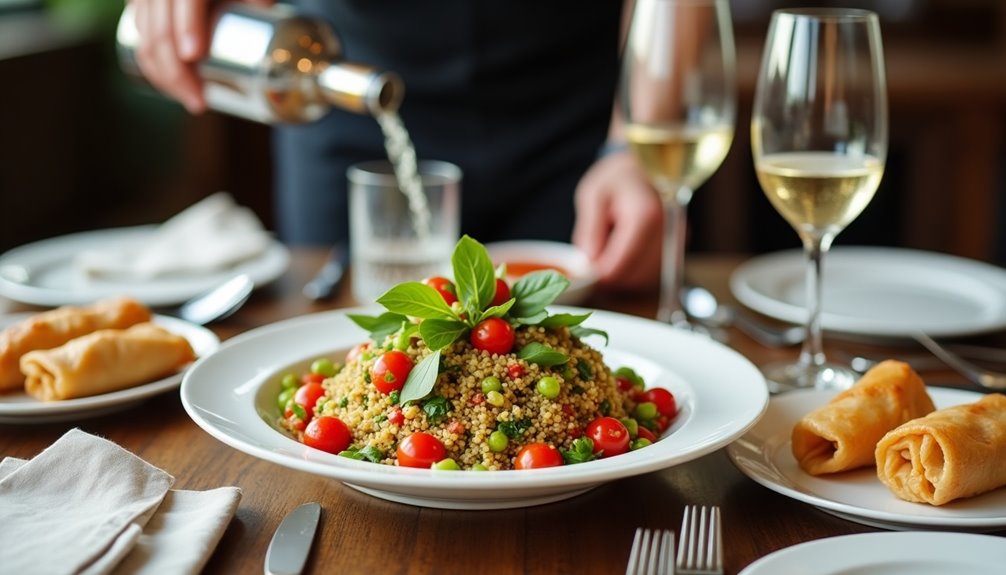
Dining out while following a gluten-free diet can feel overwhelming, but with the right approach, you can enjoy a variety of delicious meals without the worry of gluten contamination. Here are some practical tips to make your dining experience enjoyable and safe.
First, research restaurants beforehand. Look for those that offer gluten-free menu options or are known for accommodating dietary restrictions. It's always helpful to read reviews from others who have dined gluten-free at these places.
When you arrive, don't hesitate to communicate your needs. Let your server know about your gluten sensitivity and ask about cross contamination protocols. Many restaurants take this seriously and will guarantee your meal is prepared safely. Additionally, it's beneficial to understand the importance of dietary management for those with specific dietary needs.
Here's a quick reference table to help you make informed choices:
| Type of Cuisine | Menu Options |
|---|---|
| Italian | Gluten-free pasta, risotto |
| Mexican | Tacos with corn tortillas, enchiladas |
| Asian | Sushi (no soy sauce), rice dishes |
| American | Grilled meats, salads (ask for no croutons)
Frequently Asked Questions
Can Gluten-Free Diets Help With Weight Loss Effectively?
You might find that some people believe restrictive diets can boost weight loss effectively. While there are health benefits to reducing processed foods, it's important to take into account your dietary restrictions and personal needs. Simply cutting out gluten doesn't guarantee weight loss; it's about overall nutrition.
If you focus on balanced meals and whole foods, you're more likely to achieve your goals while feeling good and connected to a supportive community.
Are Gluten-Free Grains Nutritious Compared to Regular Grains?
When comparing grains, you'll often find a fascinating contrast between gluten-free and regular options. Gluten-free grains can offer impressive nutritional value, rich in fiber, vitamins, and minerals. They often support better digestive health, particularly for those sensitive to gluten.
However, some regular grains provide similar benefits. Opting for whole grains, regardless of type, is crucial to maximize nutrition and maintain a balanced diet that nurtures a sense of belonging in your eating habits.
Is Gluten Intolerance the Same as Celiac Disease?
Gluten intolerance isn't the same as celiac disease. While both can involve gluten sensitivity, they manifest differently.
Celiac disease is an autoimmune condition that leads to celiac symptoms like intestinal damage and malabsorption when gluten is consumed.
In contrast, gluten intolerance may cause discomfort without the severe consequences associated with celiac.
It's important to consult a healthcare professional for accurate diagnosis and management, ensuring you get the support you need for your health journey.
How Can I Identify Hidden Gluten in Packaged Foods?
To identify hidden gluten in packaged foods, you'll want to start by mastering gluten detection through careful package labeling. Always read ingredient lists thoroughly; look for terms like wheat, barley, and rye. Be aware that gluten can hide under different names, like malt or starch.
Many brands now provide gluten-free certifications, so keep an eye out for those labels. This way, you'll feel confident about what you're eating and find your place in a supportive community.
Is Gluten-Free Bread Healthier Than Regular Bread?
You might wonder if gluten-free bread is healthier than regular bread. While some gluten-free options offer health benefits, like being lower in calories or higher in fiber, it often depends on the ingredients.
Taste comparison shows that many prefer the texture of traditional bread, but gluten-free varieties are improving. Ultimately, it's about what works for you.
Read labels and choose options that align with your dietary needs and preferences for the best results.
Conclusion
Embracing a gluten-free diet can be a transformative journey, akin to shedding an old skin to reveal a healthier self. While the benefits are significant, navigating the challenges with informed choices and a balanced perspective is crucial. By understanding gluten, debunking myths, and making intentional food selections, you can thrive on this dietary path. So, whether you're gluten-sensitive or simply curious, take the plunge—your well-being might just blossom in ways you never expected.

